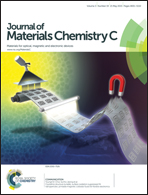Systematically tuning the ΔEST and charge balance property of bipolar hosts for low operating voltage and high power efficiency solution-processed electrophosphorescent devices†
Abstract
A series of bipolar hosts based on carbazole and phenyl benzimidazole (PBI) moieties, collectively named xCz–nPBI, were designed and synthesized. On the basis of different numbers, ratios and link-configurations of the functional groups, the influence of substitution on the chemical, photophysical and electrochemical properties of the host materials were investigated in detail. Both DFT calculations and single carrier devices demonstrate that the strategy of introducing more electron-withdrawing PBI groups in the molecules can effectively enhance the electron injection and transport ability of the bipolar host, while an increased number of carbazole units endows the hosts with a much smaller ΔEST for efficient hole injection at the cost of sacrificing their charge balance property. As a result, the solution-processed green-emitting PHOLEDs based on Cz–6PBI show an extremely low turn on voltage of 2.9 V and the highest current and power efficiency of 47.8 cd A−1 and 29.6 lm W−1, respectively. Even at luminance as high as 1000 cd m−2, their efficient roll-off was only 4.2%, which was far better than the 6Cz–PBI host device. Because the T1 energy levels and triplet state locations of these hosts are similar, their ΔEST and charge balance property should be the main factors that influence their EL performances. We conclude that it is not necessary to achieve a very small ΔEST by introducing more carbazole moieties at the cost of weakening of electron transporting ability. As for solution-processed devices, which suffer from solvent impurities and oxygen diffusion induced strong electron trapping effect, a systemic increase in the number of electron-withdrawing PBI groups in their host materials can significantly enhance the charge balance of their emission layers (EMLs) for highly power efficient solution-processed PHOLEDs.


 Please wait while we load your content...
Please wait while we load your content...